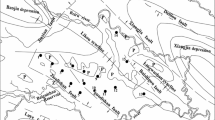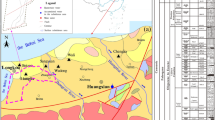Abstract
Hydrochemical analysis and Bayesian discrimination were used to identify groundwater sources for multiple aquifers in the Panyi Coal Mine, Anhui, China. The results showed that the Cenozoic top aquifer water were HCO3−Na+K−Ca and HCO3−Na+K−Mg types, which distinguished it from the other aquifers due to its low Na+ + K+ and Cl− concentrations. The Cenozoic middle and Cenozoic bottom aquifer waters were mainly Cl−Na+K and SO4−Cl−Na+K types. The water types in the Permian fractured aquifer changed from Cl−Na+K to HCO3−Cl−Na+K and HCO3−Na+K moving away from the Panji anticline. In addition, HCO3 − concentrations increased and Ca2+ concentrations decreased with depth in the aquifer. The Taiyuan limestone aquifers were of Cl−Na+K, SO4·Cl−Na+K, and HCO3·Cl−Na+K types, and are very difficult to distinguish from the other aquifers. The precision of the Bayesian discrimination based on groundwater chemistry was 86.09%. Water chemistry indicators in the Permian fractured aquifer were moderately to highly variable and moderately to strongly correlated, spatially. The water chemistry spatial distribution indicates that the Permian fractured aquifer is recharged by the Cenozoic bottom aquifer near the Panji anticline, which reduces the accuracy of Bayesian discrimination in that area.
抽象
利用水化学分析法和贝叶斯判别法识别了安徽潘一矿多含水层系统地下水源。结果表明,新生界顶部含水层水为HCO3-Na+K-Ca型和HCO3-Na+K-Mg型,以低浓度Na++K+和Cl-区别于其它含水层水。新生界中段和底部含水层水为Cl-Na+K型和SO4-Cl-Na+K型。二叠裂隙含水层水主要为Cl-Na+K型 至 HCO3-Cl-Na+K型和HCO3-Na+K型。另外,随含水层深度增大,HCO -3 浓度增大而Ca2+浓度减小。太原组灰岩含水层水类型为Cl-Na+K型、SO4·Cl-Na+K型和HCO3·Cl-Na+K型,难以与其它含水层区分。基于地下水化学特征的贝叶斯水源识别精确度达86.09%。二叠裂隙水水化学特征指标中至强变化且空间上中至强相关。水化学空间分布特征表明二叠裂隙含水层在潘一背斜附近接受新生界底部含水层水补给,贝叶斯水源判别在该区精度降低。
Zusammenfassung
Hydrochemische Analysen und Bayesianische Diskriminanzanalysen (BDA) wurden genutzt um die Grundwasserherkunft für multiple Grundwasserleiter in der Panyi Kohlenmine, Anhui, China zu identifizieren. Die Ergebnisse zeigten, dass die hangenden känozoischen Wässer vom Typ HCO3-Na+K-Ca und HCO3-Na+K-Mg sind, was sie von den anderen Aquiferen durch die geringen Na++K+ und Cl- Konzentrationen unterscheidet. Der mittlere und untere Aquifer des Känozoikums sind hauptsächlich vom Typ Cl-Na+K und SO4-Cl-Na+K. Der Wassertyp in dem geklüfteten permischen Aquifer ändert sich von Cl-Na+K zu HCO3-Cl-Na+K und HCO3-Na+K und strömt der Panji - Antiklinale ab. Zusätzlich nehmen die HCO3- Konzentrationen mit zunehmender Tiefe im Aquifer zu und die Ca2+ Konzentrationen ab. Die Grundwasserleiter des Taiyuan - Kalksteins sind vom Typ Cl-Na+K, SO4•Cl-Na+K, und HCO3•Cl-Na+K und sind sehr schwer von den anderen Grundwässern zu unterscheiden. Die Genauigkeit der BDA auf Basis der Hydrochemie ist 86.09%. Hydrochemische Indikatoren im permischen Kluftaquifer waren räumlich mäßig bis stark variabel und mäßig bis stark korreliert. Die räumliche Verteilung der Wasserchemie zeigt, dass der permische Kluftaquifer aus dem känozoischen unteren Aquifer nahe der Panji – Antiklinale angereichert wird, was die Genauigkeit der BDA in dieser Region reduziert.
Resumen
Los análisis hidroquímicos y el análisis discriminante de Bayes se utilizaron para identificar el origen de agua subterránea para acuíferos múltiples en la mina de carbón Panyi, Anhui, China. Los resultados mostraron que las aguas superiores del acuífero Cenozoico fueron del tipo HCO3-Na+K-Ca y HCO3-Na+K-Mg, lo que lo distinguió de otros acuíferos debido a su bajas concentraciones Na++K+ y Cl-. Las aguas medias e inferiores del acuífero cenozoico fueron principalmente del tipo Cl-Na+K y SO4-Cl-Na+K. Los tipos de agua en el acuífero Permian cambiaron del tipo Cl-Na+K a HCO3-Cl-Na+K y HCO3-Na+K alejándose del anticlinal Panji. En adición, las concentraciones de HCO3- se incrementaron y las concentraciones de Ca2+ decrecieron con la profundidad en el acuífero. Los acuíferos de piedra caliza Taiyuan fueron del tipo Cl-Na+K, SO4•Cl-Na+K y HCO3•Cl-Na+K y son muy difíciles de distinguir de otros acuíferos. La precisión del análisis discriminante de Bayes basado en la química del agua subterránea fue 86,09 %. Los indicadores de la química del agua en el acuífero fracturado fueron desde moderada a altamente variables y desde moderada hasta fuertemente correlacionados espacialmente. La distribución especial de la química del agua indica que el acuífero fractura es recargado por el acuífero Cenozoico inferior cerca de la anticlinal Panji que reduce la exactitud del análisis discriminante en esa área.




Similar content being viewed by others
References
Ahmadi SH, Sedghamiz A (2007) Geostatistical analysis of spatial and temporal variations of groundwater level. Environ Monit Assess 129(1–3):277–294
Antunes IMHR, Albuquerque MTD (2013) Using indicator Kriging for the evaluation of arsenic potential contamination in an abandoned mining area (Portugal). Sci Total Environ 442(15):545–552
Babiker IS, Mohamed AAM, Hiyama T (2007) Assessing groundwater quality using GIS. Water Resour Manag 21(4):699–715
Bengranine K, Marhaba TF (2003) Using principal component analysis to monitor spatial and temporal changes in water quality. J Hazard Mater 100(1–3):179–195
Christakos G (2000) Modern spatiotemporal geostatistics. Oxford University Press, Oxford
Dong W, Liu ZH (2008) Study on comprehensive evaluation of water resources carrying capacity based on FAHP principle. J Arid Land Resour Environ 10(22):6–10 (Chinese)
Duan LX, Xie MY, Bai TB, Wang JJ (2016) A new support vector data description method of machinery fault diagnosis with unbalanced datasets. Expert Syst Appl 64:239–246
Gong L, Jin CL (2009) Fuzzy comprehensive evaluation for carrying capacity of regional water resources. Water Resour Manag 23(12):2505–2513
Güler C, Thyne GD, McCray JE, Turner AK (2002) Evaluation of graphical and multivariate statistical methods for classification of water chemistry data. Hydrogeol J 10(4):455–474
Guo XD, Fu BJ, Ma KM (2000) Spatial variability of soil nutrients based on geostatistics combined with GIS: a case study in Zunghua city of Hebei province. Chin J Appl Ecol 11(4):557–563
Hobbs BF (1997) Bayesian methods for analyzing climate change and water resources uncertainties. J Environ Manag 49(4):53–72
Isaaks EH, Srivastava RM (1989) An introduction to applied geostatistics. Oxford University Press, New York
Journel AG, Huijbregts CJ (1978) Mining geostatistics. Academic Press, San Diego 17: 291–293
Júnez-Ferreira H, González J, Reyes E, Herrera GS (2016) A geostatistical methodology to evaluate the performance of groundwater quality monitoring networks using a vulnerability index. Math Geosci 48(1):25–44
Kanti KM, Rao PS (2008) Prediction of bead geometry in pulsed GMA welding using back propagation neural network. J Mater Process Technol 200(1–3):300–305
Lee SI (1997) Geostatistical model validation using orthonormal residuals. KSCE J Civ Eng 1(1):59–66
Li S, Wang Z, Shi JB, Peng B (2012) Application of fuzzy mathematics in discriminating sources of water inrush in coal mine. Safe Coal Mines 43(7):136–139 (Chinese)
Li PY, Qian H, Wu JH, Zhang YQ, Zhang HB (2013) Major ion chemistry of shallow groundwater in the Dongsheng coalfield, Ordos Basin, China. Mine Water Environ 32(3):195–206
Li PY, Qian H, Howard KWF, Wu JH, Lyu X (2014) Anthropogenic pollution and variability of manganese in alluvial sediments of the Yellow River, Ningxia, northwest China. Environ Monit Assess 186(3):1385–1398
Li PY, Qian H, Howard KWF, Wu JH (2015a) Building a new and sustainable “Silk Road economic belt”. Environ Earth Sci 74(10):7267–7270
Li PY, Qian H, Howard KWF, Wu JH (2015b) Heavy metal contamination of Yellow River alluvial sediments, northwest China. Environ Earth Sci 73(7):3403–3341
Li PY, Qian H, Zhou WF (2017) Finding harmony between the environment and humanity: an introduction to the thematic issue of the Silk Road. Environ Earth Sci 76(3):105. doi:10.1007/s12665-017-6428-9
Ma R, Shi JS, Liu JC, Gui CL (2014) Combined use of multivariate statistical analysis and hydrochemical analysis for groundwater quality evolution: a case study in North China Plain. J Earth Sci 25(3):587–597
Ma L, Qian JZ, Zhao WD, Curtis Z, Zhang RG (2016) Hydrogeochemical analysis of multiple aquifers in a coal mine based on non-linear PCA and GIS. Environ Earth Sci 75(8):1–14
Matheron BG (1971) The theory of regionalized variables and its applications. Les Cahiers du Centre de Morphologie Mathématique, Ecole Nationale Supérieure des Mines, Paris
McBain J, Timusk M (2011) Feature extraction for novelty detection as applied to fault detection in machinery. Pattern Recogn Lett 32(7):1054–1061. doi:10.1016/j.patrec.2011.01.019 (Source: DBLP)
Nikroo L, Kompani-Zare M, Sepaskhah AR, Shamsi SRF (2010) Groundwater depth and elevation interpolation by kriging methods in Mohr Basin of Fars province in Iran. Environ Monit Assess 166(1–4):387–407
Passarella G, Vurro M, D’Agostino V, Giuliano G, Barcelona MJ (2002) A probabilistic methodology to assess the risk of groundwater quality degradation. Environ Monit Assess 79(1):57–74
Rezaei M, Valipour M, Valipour M (2016) Modelling evapotranspiration to increase the accuracy of the estimations based on the climatic parameters. Water Conserv Sci Eng 1(3):1–11
Roiger RJ, Geatz MW (2003) Data mining: a tutorial based primer. Addison-Wesley Publishing Co., Boston
Schmidtt SA (1969) Measuring uncertainty: an elementary introduction to Bayesian statistics. Addison-Wesley Publishing Co., Boston
Shrestha S, Kazama f (2007) Assessment of surface water quality using multivariate statistical technique: a case study of the Fuji river basin, Japan. Environ Modell Softw 22(4):464–475
Stotler RL, Frape SK, Ruskeeniemi T, Ahonen L, Onstott TC, Hobbs MY (2009) Hydrogeochemistry of groundwater in and below the base of thick permafrost at Lupin, Nunavut, Canada. J Hydrol 373(1–2):80–95
Uddameri V (2007) Bayesian analysis of groundwater quality in a semi-arid coastal county of south Texas. Environ Geol 51(6):941–951
Valipour M (2015) Temperature analysis of reference evapotranspiration models. Meteorol Appl 22(3):385–394
Valipour M (2016a) How much meteorological information is necessary to achieve reliable accuracy for rainfall estimations? Agric 6(4):53. doi:10.3390/agriculture6040053
Valipour M (2016b) Variations of land use and irrigation for next decades under different scenarios. Irriga 1:262–288. doi:10.15809/irriga.2016v1n01p262-288
Valipour M, Banihabib ME, Behbahani SMR (2013) Comparison of the ARMA, ARIMA, and the autoregressive artificial neural network models in forecasting the monthly inflow of Dez dam reservoir. J Hydrol 476:433–441
Valipour M, Sefidkouhi MAG, Raeini-Sarjaz M (2017) Selecting the best model to estimate potential evapotranspiration with respect to climate change and magnitudes of extreme events. Agric Water Manag 180:50–60
Waltonday K, Poeter E, Thompson A, Vaughan DJ (2009) Investigating hydraulic connections and the origin of water in a mine tunnel using stable isotopes and hydrographs. Appl Geochem 24(12):2266–2282
Wang SQ, Zhu SL, Zhou CH (2001) Characteristics of spatial variability of soil thickness in China. Geogr Res 22(3):316–325
Wang LH, Li GM, Dong YH, Han DM, Zhang JY (2015) Using hydrochemical and isotopic data to determine sources of recharge and groundwater evolution in an arid region: a case study in the upper-middle reaches of the Shule River basin, northwestern China. Environ Earth Sci 73(4):1901–1915
Wu Y, Yu ZC (2011) Application of neural network in water source distinguishing of mine water inrush. Ind Mine Automat 60–62 (Chinese)
Wu Q, Zhou WF (2008) Prediction of groundwater inrush into coal mines from aquifers underlying the coal seams in China: vulnerability index method and its construction. Environ Geol 56(2):245–254
Wu J, Li P, Qian H, Duan Z, Zhang X (2014a) Using correlation and multivariate statistical analysis to identify hydrogeochemical processes affecting the major ion chemistry of waters: case study in Laoheba phosphorite mine in Sichuan, China. Arab J Geosci 7(10):3973–3982
Wu WY, Yin SY, Liu HL, Niu Y, Bao Z (2014b) The geostatistic-based spatial distribution variations of soil salts under long-term wastewater irrigation. Environ Monit Assess 186(10):6747–6756
Wunderlin DA, Diaz MP, Ame MV, Pesce SF, Hued AC, Bistoni MA (2001) Pattern recognition techniques for the evaluation of spatial and temporal variations in water quality. A case study: Suquia river basin (Cordoba, Argentina). Water Res 35(12):2881–2894
Xing YF, Zhang C, Wang JH (2016) Analysis and regularity of China’s coal mine water inrush accident in 2007 ~ 2014. Coal Technol 25(7):186–188 (Chinese)
Yang DD, Ma L, Qian JZ, Chen LW, Cao XC (2010) Water inrush source of Xinzhuangzi coal mine identified with gray related degree method. In: Proc. 3rd international conf on environmental technology and knowledge transfer, UK, pp 981–984
Zhang CL, Qian JZ, Zhao WD, Ma L (2010) The application of Bayesian approach to discrimination of mine water-inrush source. Coal Geol Explor 38(4):34–37 (Chinese)
Zhao J, Fu G, Lei K, Li YW (2011) Multivariate analysis of surface water quality in the Three Gorges area of China and implications for water management. J Environ Sci 23(9):1460–1471
Acknowledgements
This research was supported by the National Natural Science Foundation of China (Nos. 41602256, 41641021, and 41301537) and the Science and Technology Fund of Land and Resources of Anhui Province (2016-k-11).
Author information
Authors and Affiliations
Corresponding author
Rights and permissions
About this article
Cite this article
Qian, J., Tong, Y., Ma, L. et al. Hydrochemical Characteristics and Groundwater Source Identification of a Multiple Aquifer System in a Coal Mine. Mine Water Environ 37, 528–540 (2018). https://doi.org/10.1007/s10230-017-0493-x
Received:
Accepted:
Published:
Issue Date:
DOI: https://doi.org/10.1007/s10230-017-0493-x




